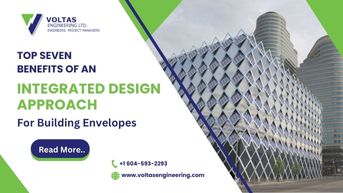The integrated design approach involves a group of people working together to make a smart building’s cover. They consider the looks of the building and are also concerned about its strength, how it keeps warmth inside, and how it affects nature.
Many factors need to be considered during such planning. Engineering considers each factor and ensures the good looks and functionality of the building. The right approach is crucial for building envelopes that are both pretty and functional.

7 Benefits of an Integrated Design Approach for Building Envelopes
Energy Efficiency and Sustainability
Engineering can help buildings use less energy with smart design. They plan the outer parts carefully. When they follow the integrated design, we put things like insulation, glass, shades, and systems in the right place.
All things are compiled and worked together to make the building cozy and save energy. This energy plan will keep your building working well for a long time, which can be good for wallets as well as nature.
Improved Indoor Comfort
The architecture of a building can have a significant impact on internal comfort by controlling temperature, humidity, and air quality. A comfortable environment for inhabitants can be created by utilizing comprehensive thermal modeling, detailed daylight analysis, and novel ventilation systems. Careful insulation and ventilation may keep drafts and temperature swings at bay, preventing condensation and creating a comfortable and healthy living environment.
Enhanced Durability and Longevity
When the design of a building’s exterior walls and structural systems are coordinated, they create a strong defense against the effects of time. This coordination is like a well-rehearsed dance, protecting the structure from issues like water damage, deterioration, and loss of strength. By carefully selecting materials and paying attention to details, the building envelope becomes resilient enough to withstand normal wear and tear without requiring frequent maintenance. In short, this coordinated approach ensures the building can stand the test of time.
Aesthetic and Architectural Excellence
The purpose of a building envelope goes beyond mere functionality. It serves as a canvas for architectural brilliance to create a masterpiece. When architectural design and envelope performance are integrated, a harmonious synergy emerges. This brings about facades that not only look aesthetically significant but also serve their intended purpose. This creative combination results in new design solutions that balance form and function, resulting in structures that are both pleasing to the senses and practical.
Cost Savings and Reduced Waste
When implementing an integrated design approach, it is important to make wise financial decisions. By having proactive and collaborative design discussions, you can identify and address any potential challenges and conflicts early on. This can result in cost-effective solutions and prevent costly adjustments during construction. It’s also important to use resources and materials efficiently to achieve this approach. This philosophy should be carried over throughout the operational lifecycle, as optimizing energy consumption and reducing maintenance needs can lead to lower operational costs in the long run.
Regulatory Compliance
Think of integrated design as a watchful protector when it comes to following rules and regulations. This careful way of doing things blends the important rules of building with the actual design process. Stuff like making sure buildings are safe from fires and easy to use for everyone gets considered from the very start. This smart thinking not only helps handle possible troubles when getting permissions and approvals but also makes the building strong and trustworthy within the law.
Reduced Risk of Failures
Imagine integrated design like a teamwork hub where people work together and use smart computer tests to find and fix problems in the design early on. This planned and careful way of doing things acts like a strong shield against problems like leaks or things that might make the building weak. By taking this active approach, problems are found and fixed early, which means the chances of having to pay a lot to fix things later or going through long legal battles are way smaller. So, this way of thinking isn’t just about fixing problems; it’s also about stopping them from happening in the first place, which is like being smart and careful from the start.
Conclusion
Taking an integrated design approach when constructing building envelopes offers a range of benefits that go beyond the individual components. This approach acts as a guiding light, directing the construction industry towards a future where buildings are more than just functional but also excel in energy efficiency, comfort, and resilience. These structures are not just practical but also architectural wonders that seamlessly blend aesthetics with functionality. By bringing together a variety of expertise under one encompassing perspective, this approach forms the foundation on which exceptional structures are built – structures that demonstrate sustainability, innovation, and the true art of design. Contact Surrey-based Voltas Engineering for the best envelope energy design.


